Taxation in Ireland: Assessment, Tax Credits, and Recent Changes
VerifiedAdded on 2023/06/03
|13
|2828
|86
AI Summary
This article explains the assessment rules for taxation in Ireland, including the rules for short life businesses. It also covers tax credits, including the personal tax credit and the PAYEE tax credit. The article discusses recent changes in the law, such as the KEEP scheme, USC rate, and anti-avoidance legislation for MBOs and corporate restructurings.
Contribute Materials
Your contribution can guide someone’s learning journey. Share your
documents today.
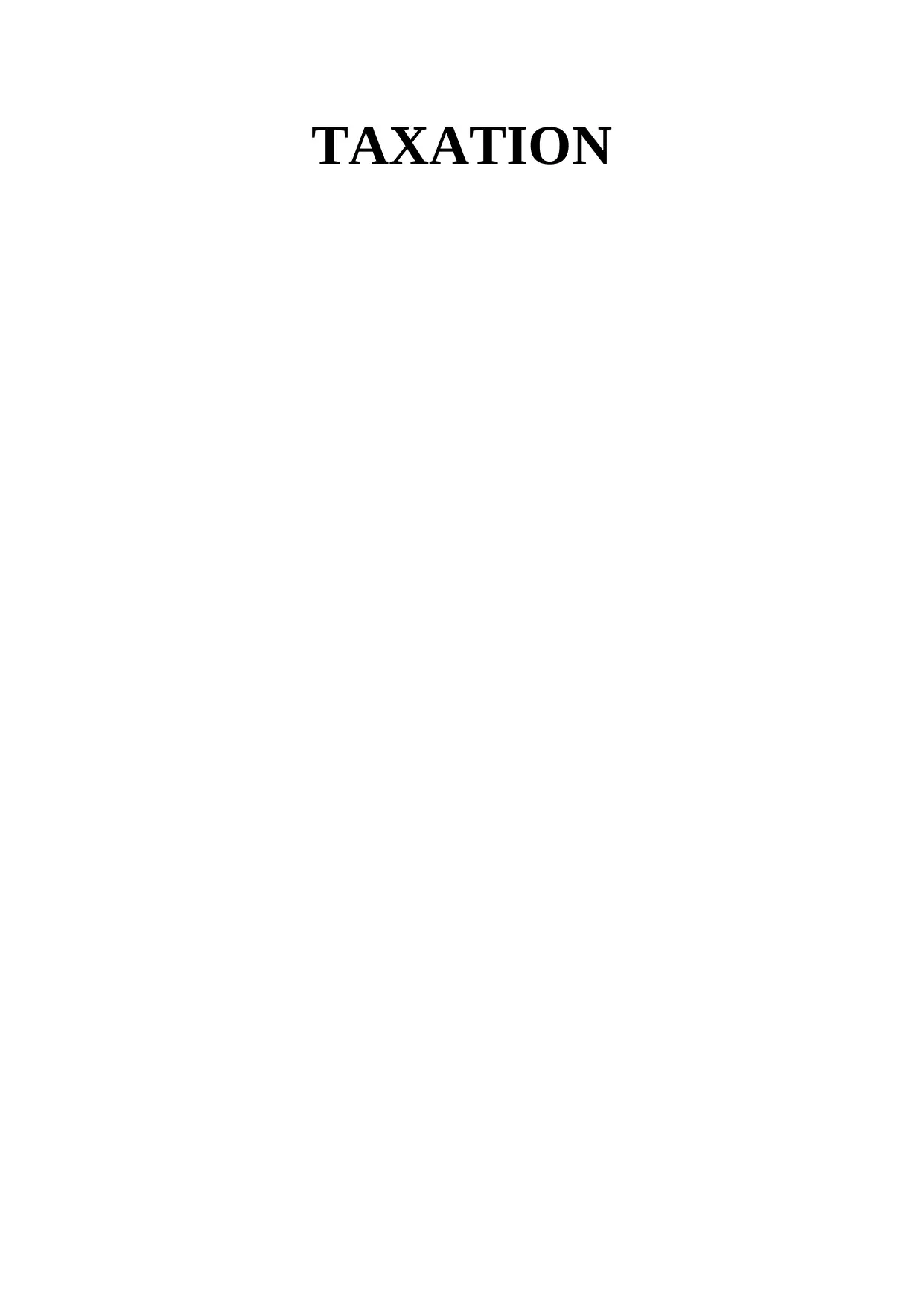
TAXATION
Secure Best Marks with AI Grader
Need help grading? Try our AI Grader for instant feedback on your assignments.
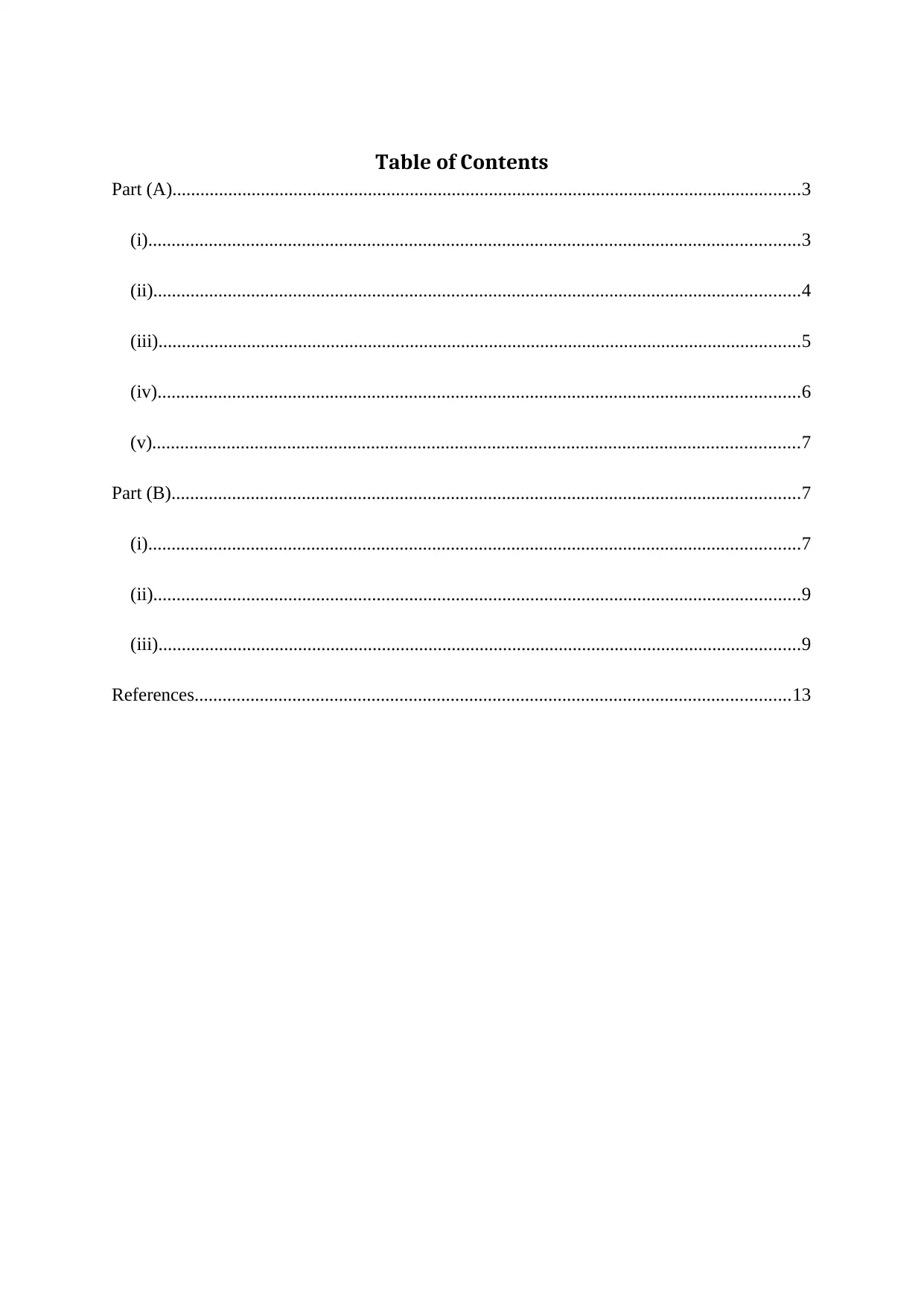
Table of Contents
Part (A).......................................................................................................................................3
(i)............................................................................................................................................3
(ii)...........................................................................................................................................4
(iii)..........................................................................................................................................5
(iv)..........................................................................................................................................6
(v)...........................................................................................................................................7
Part (B).......................................................................................................................................7
(i)............................................................................................................................................7
(ii)...........................................................................................................................................9
(iii)..........................................................................................................................................9
References................................................................................................................................13
Part (A).......................................................................................................................................3
(i)............................................................................................................................................3
(ii)...........................................................................................................................................4
(iii)..........................................................................................................................................5
(iv)..........................................................................................................................................6
(v)...........................................................................................................................................7
Part (B).......................................................................................................................................7
(i)............................................................................................................................................7
(ii)...........................................................................................................................................9
(iii)..........................................................................................................................................9
References................................................................................................................................13
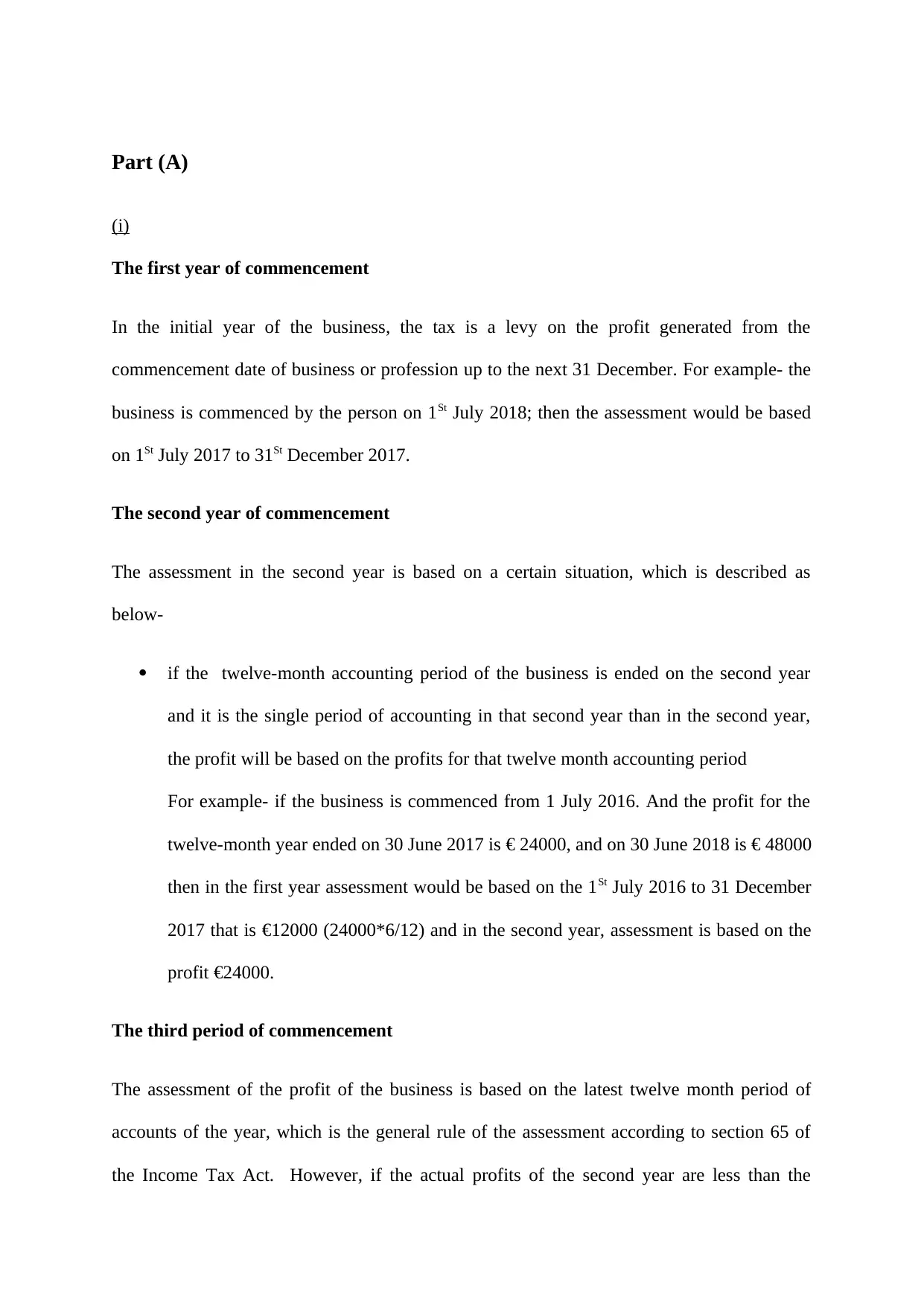
Part (A)
(i)
The first year of commencement
In the initial year of the business, the tax is a levy on the profit generated from the
commencement date of business or profession up to the next 31 December. For example- the
business is commenced by the person on 1St July 2018; then the assessment would be based
on 1St July 2017 to 31St December 2017.
The second year of commencement
The assessment in the second year is based on a certain situation, which is described as
below-
if the twelve-month accounting period of the business is ended on the second year
and it is the single period of accounting in that second year than in the second year,
the profit will be based on the profits for that twelve month accounting period
For example- if the business is commenced from 1 July 2016. And the profit for the
twelve-month year ended on 30 June 2017 is € 24000, and on 30 June 2018 is € 48000
then in the first year assessment would be based on the 1St July 2016 to 31 December
2017 that is €12000 (24000*6/12) and in the second year, assessment is based on the
profit €24000.
The third period of commencement
The assessment of the profit of the business is based on the latest twelve month period of
accounts of the year, which is the general rule of the assessment according to section 65 of
the Income Tax Act. However, if the actual profits of the second year are less than the
(i)
The first year of commencement
In the initial year of the business, the tax is a levy on the profit generated from the
commencement date of business or profession up to the next 31 December. For example- the
business is commenced by the person on 1St July 2018; then the assessment would be based
on 1St July 2017 to 31St December 2017.
The second year of commencement
The assessment in the second year is based on a certain situation, which is described as
below-
if the twelve-month accounting period of the business is ended on the second year
and it is the single period of accounting in that second year than in the second year,
the profit will be based on the profits for that twelve month accounting period
For example- if the business is commenced from 1 July 2016. And the profit for the
twelve-month year ended on 30 June 2017 is € 24000, and on 30 June 2018 is € 48000
then in the first year assessment would be based on the 1St July 2016 to 31 December
2017 that is €12000 (24000*6/12) and in the second year, assessment is based on the
profit €24000.
The third period of commencement
The assessment of the profit of the business is based on the latest twelve month period of
accounts of the year, which is the general rule of the assessment according to section 65 of
the Income Tax Act. However, if the actual profits of the second year are less than the
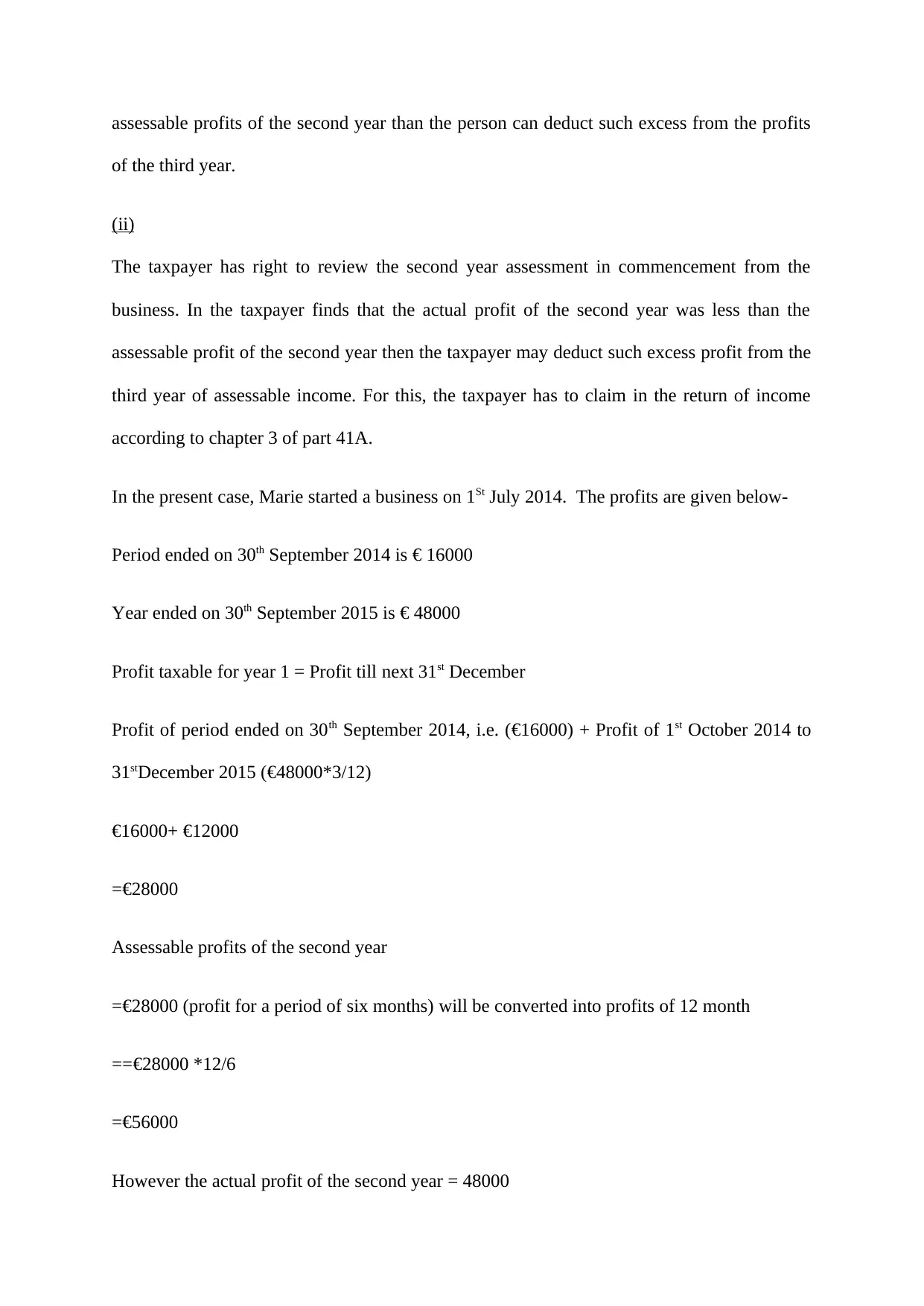
assessable profits of the second year than the person can deduct such excess from the profits
of the third year.
(ii)
The taxpayer has right to review the second year assessment in commencement from the
business. In the taxpayer finds that the actual profit of the second year was less than the
assessable profit of the second year then the taxpayer may deduct such excess profit from the
third year of assessable income. For this, the taxpayer has to claim in the return of income
according to chapter 3 of part 41A.
In the present case, Marie started a business on 1St July 2014. The profits are given below-
Period ended on 30th September 2014 is € 16000
Year ended on 30th September 2015 is € 48000
Profit taxable for year 1 = Profit till next 31st December
Profit of period ended on 30th September 2014, i.e. (€16000) + Profit of 1st October 2014 to
31stDecember 2015 (€48000*3/12)
€16000+ €12000
=€28000
Assessable profits of the second year
=€28000 (profit for a period of six months) will be converted into profits of 12 month
==€28000 *12/6
=€56000
However the actual profit of the second year = 48000
of the third year.
(ii)
The taxpayer has right to review the second year assessment in commencement from the
business. In the taxpayer finds that the actual profit of the second year was less than the
assessable profit of the second year then the taxpayer may deduct such excess profit from the
third year of assessable income. For this, the taxpayer has to claim in the return of income
according to chapter 3 of part 41A.
In the present case, Marie started a business on 1St July 2014. The profits are given below-
Period ended on 30th September 2014 is € 16000
Year ended on 30th September 2015 is € 48000
Profit taxable for year 1 = Profit till next 31st December
Profit of period ended on 30th September 2014, i.e. (€16000) + Profit of 1st October 2014 to
31stDecember 2015 (€48000*3/12)
€16000+ €12000
=€28000
Assessable profits of the second year
=€28000 (profit for a period of six months) will be converted into profits of 12 month
==€28000 *12/6
=€56000
However the actual profit of the second year = 48000
Secure Best Marks with AI Grader
Need help grading? Try our AI Grader for instant feedback on your assignments.
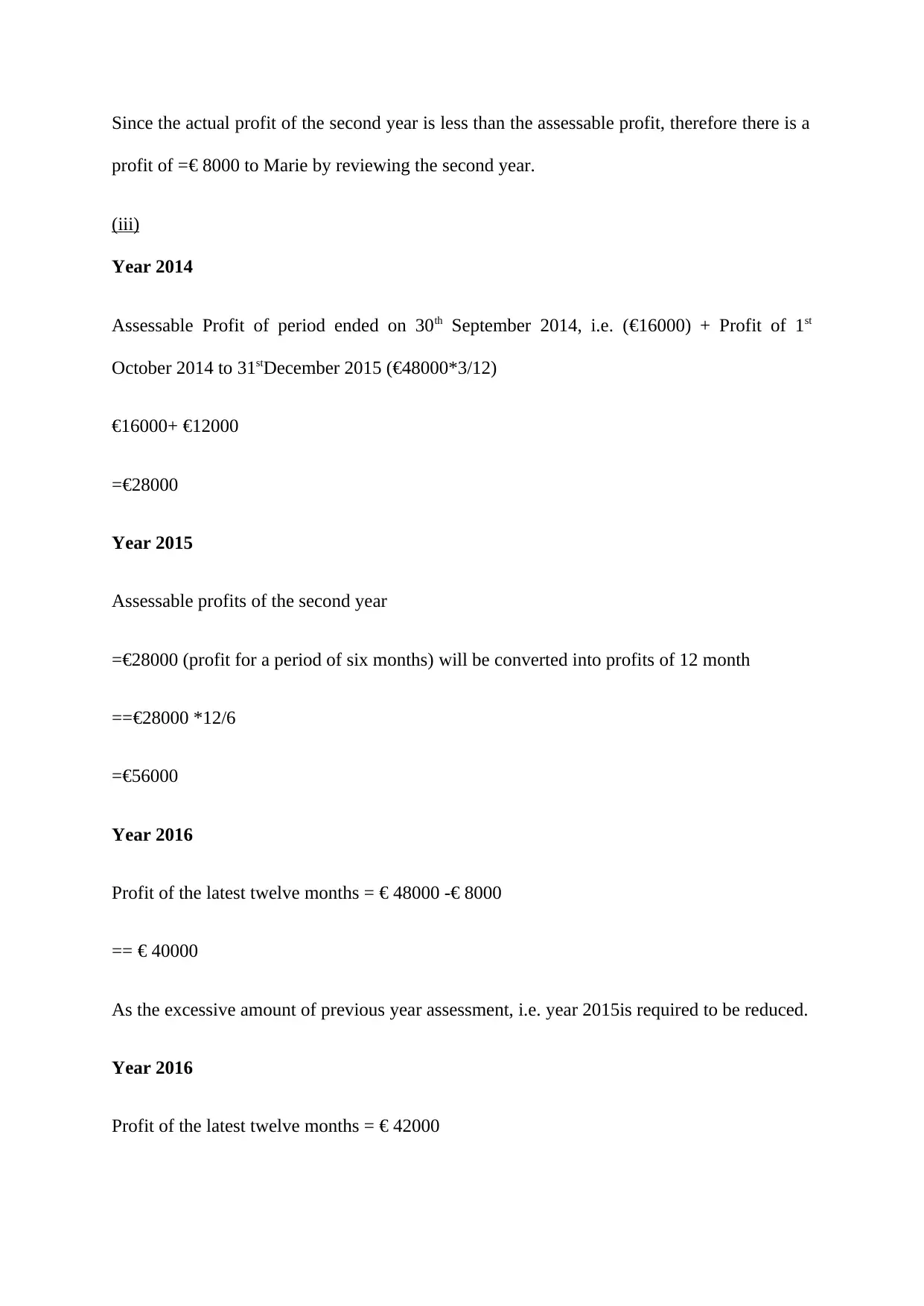
Since the actual profit of the second year is less than the assessable profit, therefore there is a
profit of =€ 8000 to Marie by reviewing the second year.
(iii)
Year 2014
Assessable Profit of period ended on 30th September 2014, i.e. (€16000) + Profit of 1st
October 2014 to 31stDecember 2015 (€48000*3/12)
€16000+ €12000
=€28000
Year 2015
Assessable profits of the second year
=€28000 (profit for a period of six months) will be converted into profits of 12 month
==€28000 *12/6
=€56000
Year 2016
Profit of the latest twelve months = € 48000 -€ 8000
== € 40000
As the excessive amount of previous year assessment, i.e. year 2015is required to be reduced.
Year 2016
Profit of the latest twelve months = € 42000
profit of =€ 8000 to Marie by reviewing the second year.
(iii)
Year 2014
Assessable Profit of period ended on 30th September 2014, i.e. (€16000) + Profit of 1st
October 2014 to 31stDecember 2015 (€48000*3/12)
€16000+ €12000
=€28000
Year 2015
Assessable profits of the second year
=€28000 (profit for a period of six months) will be converted into profits of 12 month
==€28000 *12/6
=€56000
Year 2016
Profit of the latest twelve months = € 48000 -€ 8000
== € 40000
As the excessive amount of previous year assessment, i.e. year 2015is required to be reduced.
Year 2016
Profit of the latest twelve months = € 42000
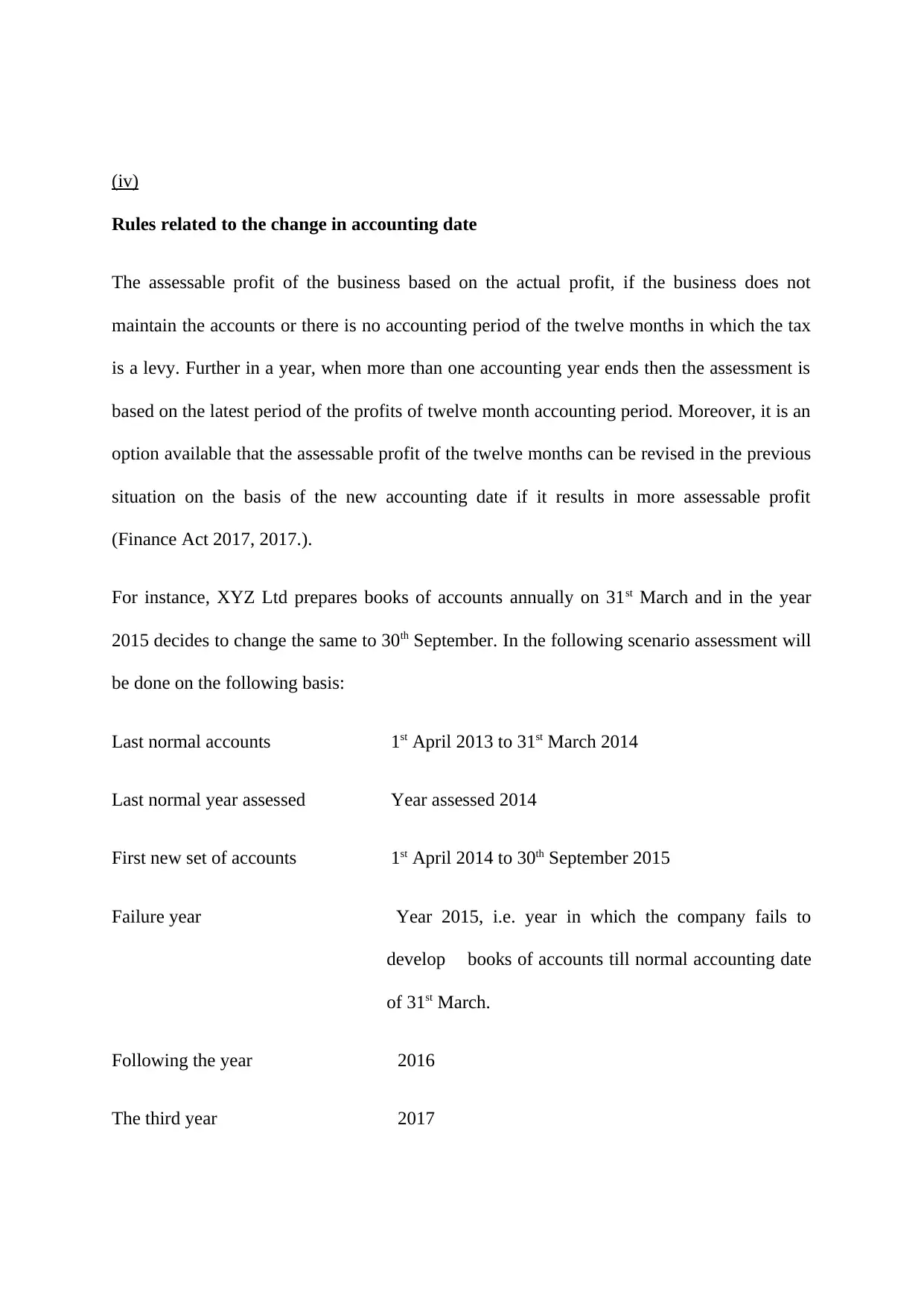
(iv)
Rules related to the change in accounting date
The assessable profit of the business based on the actual profit, if the business does not
maintain the accounts or there is no accounting period of the twelve months in which the tax
is a levy. Further in a year, when more than one accounting year ends then the assessment is
based on the latest period of the profits of twelve month accounting period. Moreover, it is an
option available that the assessable profit of the twelve months can be revised in the previous
situation on the basis of the new accounting date if it results in more assessable profit
(Finance Act 2017, 2017.).
For instance, XYZ Ltd prepares books of accounts annually on 31st March and in the year
2015 decides to change the same to 30th September. In the following scenario assessment will
be done on the following basis:
Last normal accounts 1st April 2013 to 31st March 2014
Last normal year assessed Year assessed 2014
First new set of accounts 1st April 2014 to 30th September 2015
Failure year Year 2015, i.e. year in which the company fails to
develop books of accounts till normal accounting date
of 31st March.
Following the year 2016
The third year 2017
Rules related to the change in accounting date
The assessable profit of the business based on the actual profit, if the business does not
maintain the accounts or there is no accounting period of the twelve months in which the tax
is a levy. Further in a year, when more than one accounting year ends then the assessment is
based on the latest period of the profits of twelve month accounting period. Moreover, it is an
option available that the assessable profit of the twelve months can be revised in the previous
situation on the basis of the new accounting date if it results in more assessable profit
(Finance Act 2017, 2017.).
For instance, XYZ Ltd prepares books of accounts annually on 31st March and in the year
2015 decides to change the same to 30th September. In the following scenario assessment will
be done on the following basis:
Last normal accounts 1st April 2013 to 31st March 2014
Last normal year assessed Year assessed 2014
First new set of accounts 1st April 2014 to 30th September 2015
Failure year Year 2015, i.e. year in which the company fails to
develop books of accounts till normal accounting date
of 31st March.
Following the year 2016
The third year 2017
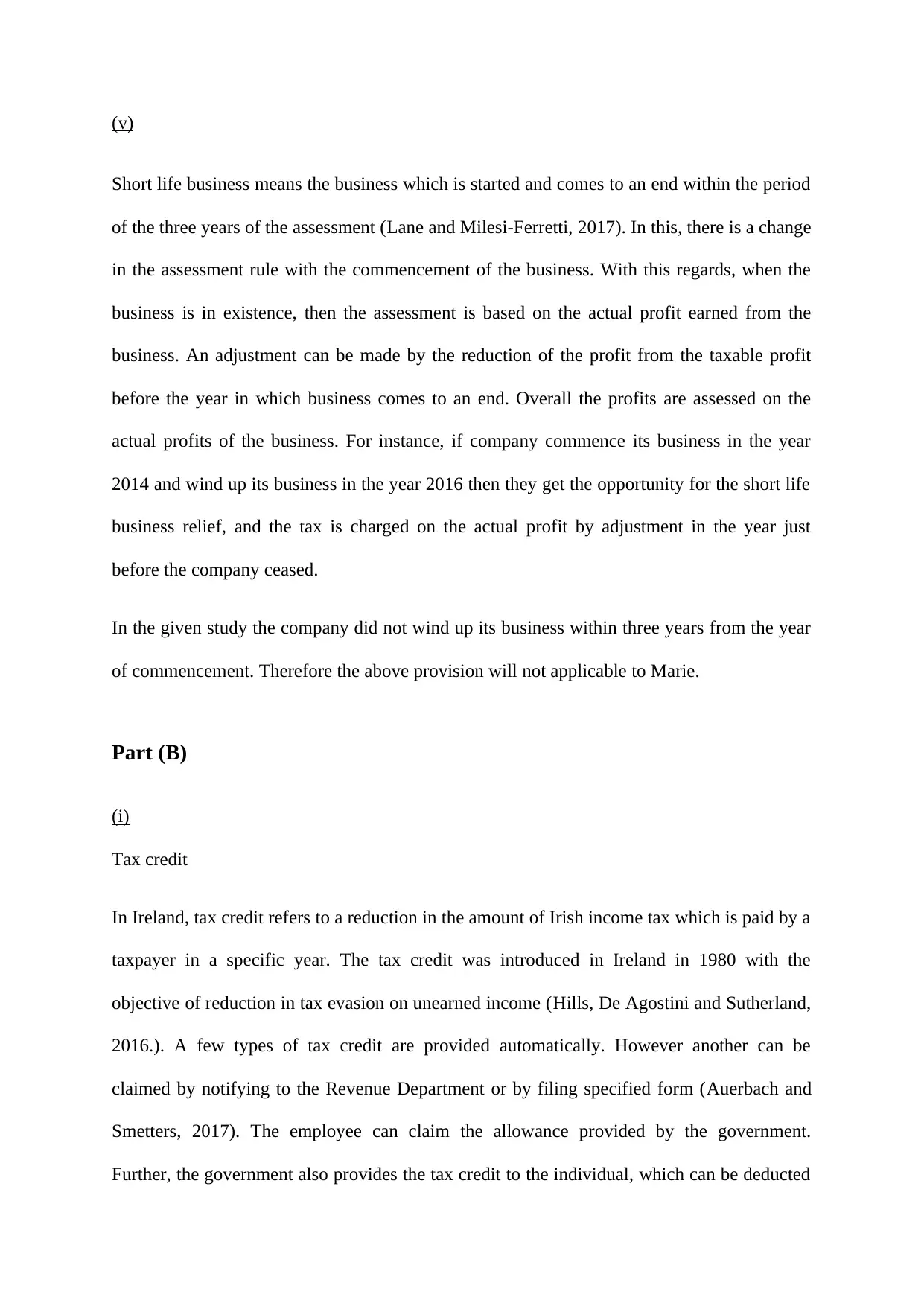
(v)
Short life business means the business which is started and comes to an end within the period
of the three years of the assessment (Lane and Milesi-Ferretti, 2017). In this, there is a change
in the assessment rule with the commencement of the business. With this regards, when the
business is in existence, then the assessment is based on the actual profit earned from the
business. An adjustment can be made by the reduction of the profit from the taxable profit
before the year in which business comes to an end. Overall the profits are assessed on the
actual profits of the business. For instance, if company commence its business in the year
2014 and wind up its business in the year 2016 then they get the opportunity for the short life
business relief, and the tax is charged on the actual profit by adjustment in the year just
before the company ceased.
In the given study the company did not wind up its business within three years from the year
of commencement. Therefore the above provision will not applicable to Marie.
Part (B)
(i)
Tax credit
In Ireland, tax credit refers to a reduction in the amount of Irish income tax which is paid by a
taxpayer in a specific year. The tax credit was introduced in Ireland in 1980 with the
objective of reduction in tax evasion on unearned income (Hills, De Agostini and Sutherland,
2016.). A few types of tax credit are provided automatically. However another can be
claimed by notifying to the Revenue Department or by filing specified form (Auerbach and
Smetters, 2017). The employee can claim the allowance provided by the government.
Further, the government also provides the tax credit to the individual, which can be deducted
Short life business means the business which is started and comes to an end within the period
of the three years of the assessment (Lane and Milesi-Ferretti, 2017). In this, there is a change
in the assessment rule with the commencement of the business. With this regards, when the
business is in existence, then the assessment is based on the actual profit earned from the
business. An adjustment can be made by the reduction of the profit from the taxable profit
before the year in which business comes to an end. Overall the profits are assessed on the
actual profits of the business. For instance, if company commence its business in the year
2014 and wind up its business in the year 2016 then they get the opportunity for the short life
business relief, and the tax is charged on the actual profit by adjustment in the year just
before the company ceased.
In the given study the company did not wind up its business within three years from the year
of commencement. Therefore the above provision will not applicable to Marie.
Part (B)
(i)
Tax credit
In Ireland, tax credit refers to a reduction in the amount of Irish income tax which is paid by a
taxpayer in a specific year. The tax credit was introduced in Ireland in 1980 with the
objective of reduction in tax evasion on unearned income (Hills, De Agostini and Sutherland,
2016.). A few types of tax credit are provided automatically. However another can be
claimed by notifying to the Revenue Department or by filing specified form (Auerbach and
Smetters, 2017). The employee can claim the allowance provided by the government.
Further, the government also provides the tax credit to the individual, which can be deducted
Paraphrase This Document
Need a fresh take? Get an instant paraphrase of this document with our AI Paraphraser
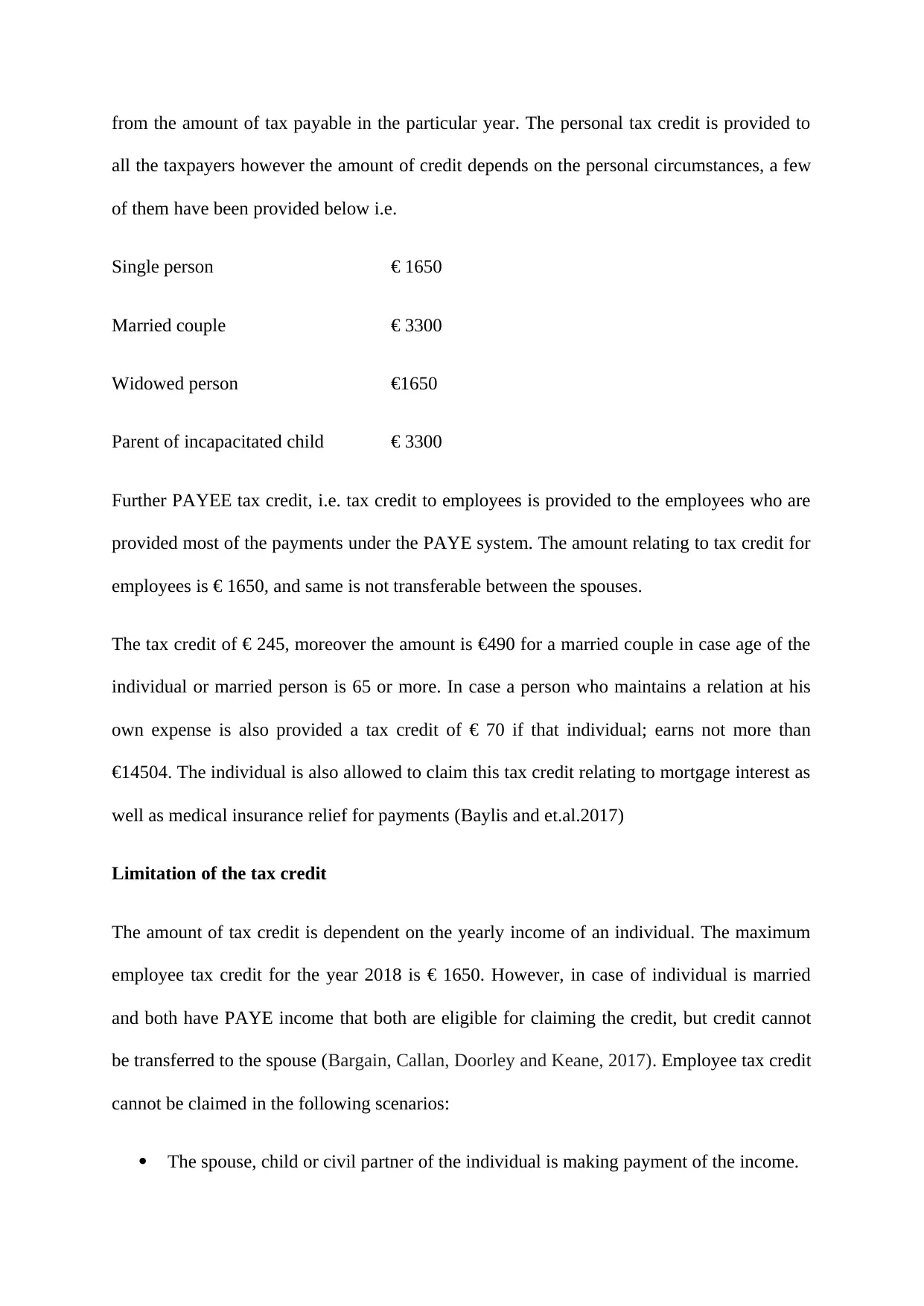
from the amount of tax payable in the particular year. The personal tax credit is provided to
all the taxpayers however the amount of credit depends on the personal circumstances, a few
of them have been provided below i.e.
Single person € 1650
Married couple € 3300
Widowed person €1650
Parent of incapacitated child € 3300
Further PAYEE tax credit, i.e. tax credit to employees is provided to the employees who are
provided most of the payments under the PAYE system. The amount relating to tax credit for
employees is € 1650, and same is not transferable between the spouses.
The tax credit of € 245, moreover the amount is €490 for a married couple in case age of the
individual or married person is 65 or more. In case a person who maintains a relation at his
own expense is also provided a tax credit of € 70 if that individual; earns not more than
€14504. The individual is also allowed to claim this tax credit relating to mortgage interest as
well as medical insurance relief for payments (Baylis and et.al.2017)
Limitation of the tax credit
The amount of tax credit is dependent on the yearly income of an individual. The maximum
employee tax credit for the year 2018 is € 1650. However, in case of individual is married
and both have PAYE income that both are eligible for claiming the credit, but credit cannot
be transferred to the spouse (Bargain, Callan, Doorley and Keane, 2017). Employee tax credit
cannot be claimed in the following scenarios:
The spouse, child or civil partner of the individual is making payment of the income.
all the taxpayers however the amount of credit depends on the personal circumstances, a few
of them have been provided below i.e.
Single person € 1650
Married couple € 3300
Widowed person €1650
Parent of incapacitated child € 3300
Further PAYEE tax credit, i.e. tax credit to employees is provided to the employees who are
provided most of the payments under the PAYE system. The amount relating to tax credit for
employees is € 1650, and same is not transferable between the spouses.
The tax credit of € 245, moreover the amount is €490 for a married couple in case age of the
individual or married person is 65 or more. In case a person who maintains a relation at his
own expense is also provided a tax credit of € 70 if that individual; earns not more than
€14504. The individual is also allowed to claim this tax credit relating to mortgage interest as
well as medical insurance relief for payments (Baylis and et.al.2017)
Limitation of the tax credit
The amount of tax credit is dependent on the yearly income of an individual. The maximum
employee tax credit for the year 2018 is € 1650. However, in case of individual is married
and both have PAYE income that both are eligible for claiming the credit, but credit cannot
be transferred to the spouse (Bargain, Callan, Doorley and Keane, 2017). Employee tax credit
cannot be claimed in the following scenarios:
The spouse, child or civil partner of the individual is making payment of the income.
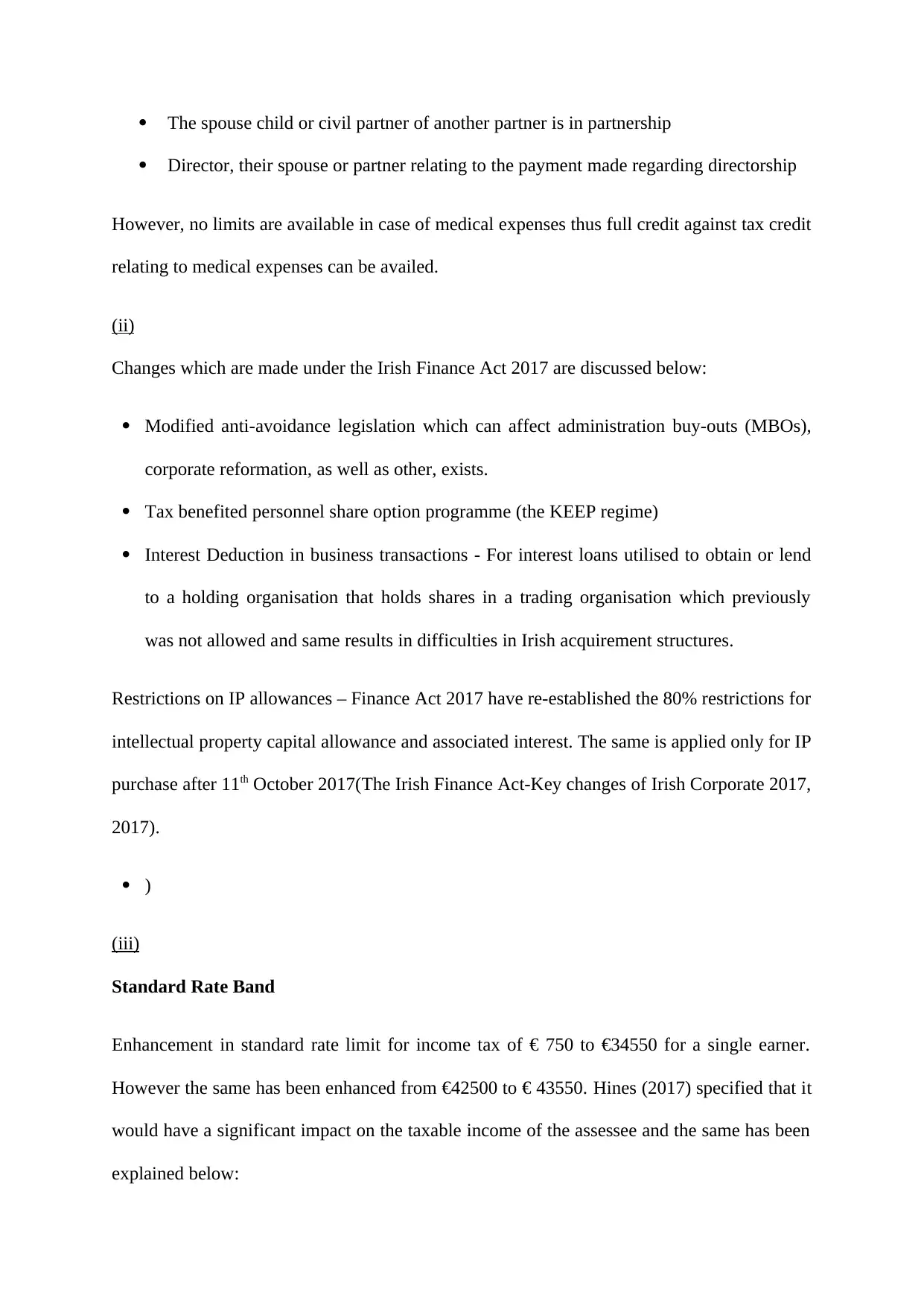
The spouse child or civil partner of another partner is in partnership
Director, their spouse or partner relating to the payment made regarding directorship
However, no limits are available in case of medical expenses thus full credit against tax credit
relating to medical expenses can be availed.
(ii)
Changes which are made under the Irish Finance Act 2017 are discussed below:
Modified anti-avoidance legislation which can affect administration buy-outs (MBOs),
corporate reformation, as well as other, exists.
Tax benefited personnel share option programme (the KEEP regime)
Interest Deduction in business transactions - For interest loans utilised to obtain or lend
to a holding organisation that holds shares in a trading organisation which previously
was not allowed and same results in difficulties in Irish acquirement structures.
Restrictions on IP allowances – Finance Act 2017 have re-established the 80% restrictions for
intellectual property capital allowance and associated interest. The same is applied only for IP
purchase after 11th October 2017(The Irish Finance Act-Key changes of Irish Corporate 2017,
2017).
)
(iii)
Standard Rate Band
Enhancement in standard rate limit for income tax of € 750 to €34550 for a single earner.
However the same has been enhanced from €42500 to € 43550. Hines (2017) specified that it
would have a significant impact on the taxable income of the assessee and the same has been
explained below:
Director, their spouse or partner relating to the payment made regarding directorship
However, no limits are available in case of medical expenses thus full credit against tax credit
relating to medical expenses can be availed.
(ii)
Changes which are made under the Irish Finance Act 2017 are discussed below:
Modified anti-avoidance legislation which can affect administration buy-outs (MBOs),
corporate reformation, as well as other, exists.
Tax benefited personnel share option programme (the KEEP regime)
Interest Deduction in business transactions - For interest loans utilised to obtain or lend
to a holding organisation that holds shares in a trading organisation which previously
was not allowed and same results in difficulties in Irish acquirement structures.
Restrictions on IP allowances – Finance Act 2017 have re-established the 80% restrictions for
intellectual property capital allowance and associated interest. The same is applied only for IP
purchase after 11th October 2017(The Irish Finance Act-Key changes of Irish Corporate 2017,
2017).
)
(iii)
Standard Rate Band
Enhancement in standard rate limit for income tax of € 750 to €34550 for a single earner.
However the same has been enhanced from €42500 to € 43550. Hines (2017) specified that it
would have a significant impact on the taxable income of the assessee and the same has been
explained below:
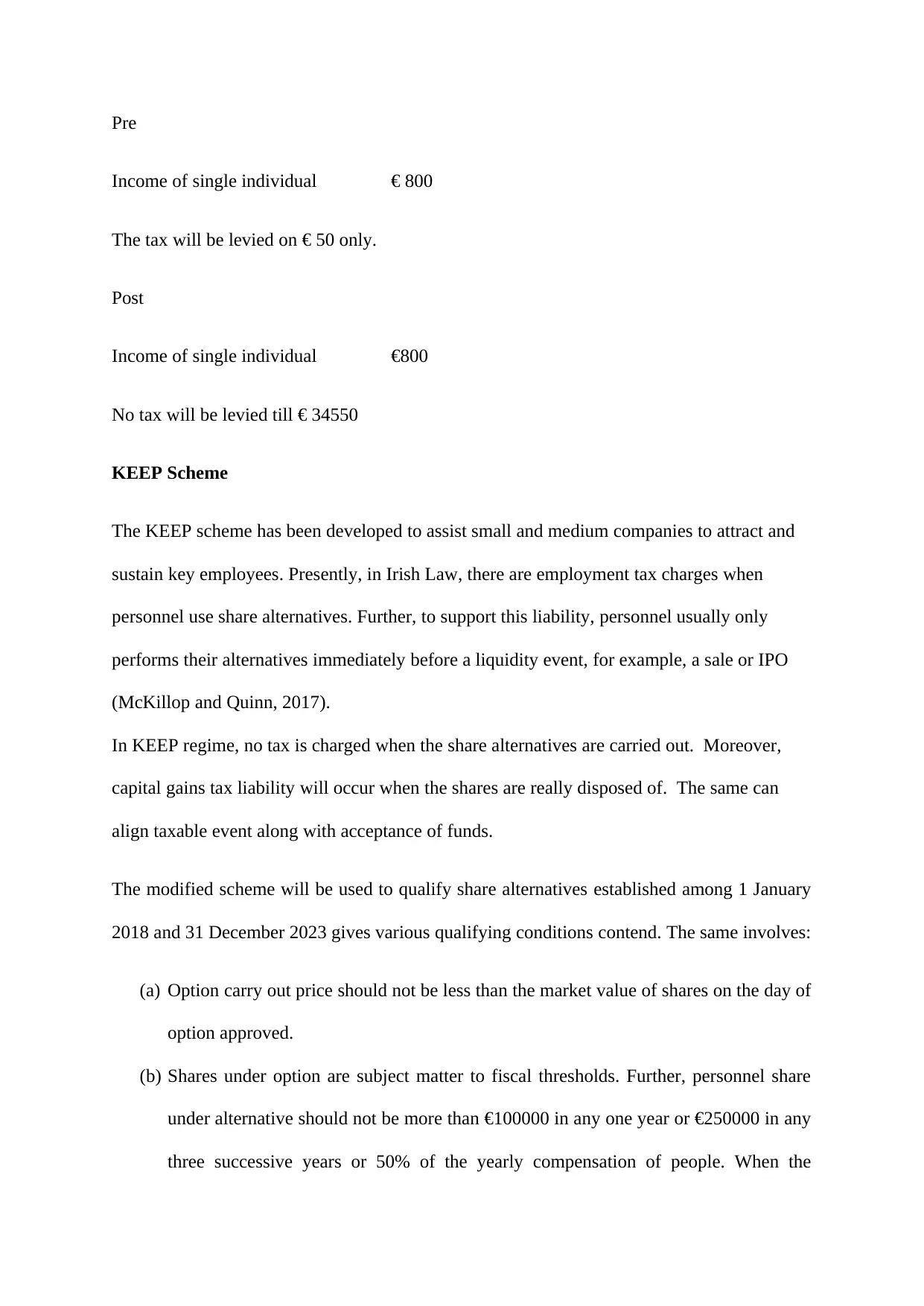
Pre
Income of single individual € 800
The tax will be levied on € 50 only.
Post
Income of single individual €800
No tax will be levied till € 34550
KEEP Scheme
The KEEP scheme has been developed to assist small and medium companies to attract and
sustain key employees. Presently, in Irish Law, there are employment tax charges when
personnel use share alternatives. Further, to support this liability, personnel usually only
performs their alternatives immediately before a liquidity event, for example, a sale or IPO
(McKillop and Quinn, 2017).
In KEEP regime, no tax is charged when the share alternatives are carried out. Moreover,
capital gains tax liability will occur when the shares are really disposed of. The same can
align taxable event along with acceptance of funds.
The modified scheme will be used to qualify share alternatives established among 1 January
2018 and 31 December 2023 gives various qualifying conditions contend. The same involves:
(a) Option carry out price should not be less than the market value of shares on the day of
option approved.
(b) Shares under option are subject matter to fiscal thresholds. Further, personnel share
under alternative should not be more than €100000 in any one year or €250000 in any
three successive years or 50% of the yearly compensation of people. When the
Income of single individual € 800
The tax will be levied on € 50 only.
Post
Income of single individual €800
No tax will be levied till € 34550
KEEP Scheme
The KEEP scheme has been developed to assist small and medium companies to attract and
sustain key employees. Presently, in Irish Law, there are employment tax charges when
personnel use share alternatives. Further, to support this liability, personnel usually only
performs their alternatives immediately before a liquidity event, for example, a sale or IPO
(McKillop and Quinn, 2017).
In KEEP regime, no tax is charged when the share alternatives are carried out. Moreover,
capital gains tax liability will occur when the shares are really disposed of. The same can
align taxable event along with acceptance of funds.
The modified scheme will be used to qualify share alternatives established among 1 January
2018 and 31 December 2023 gives various qualifying conditions contend. The same involves:
(a) Option carry out price should not be less than the market value of shares on the day of
option approved.
(b) Shares under option are subject matter to fiscal thresholds. Further, personnel share
under alternative should not be more than €100000 in any one year or €250000 in any
three successive years or 50% of the yearly compensation of people. When the
Secure Best Marks with AI Grader
Need help grading? Try our AI Grader for instant feedback on your assignments.
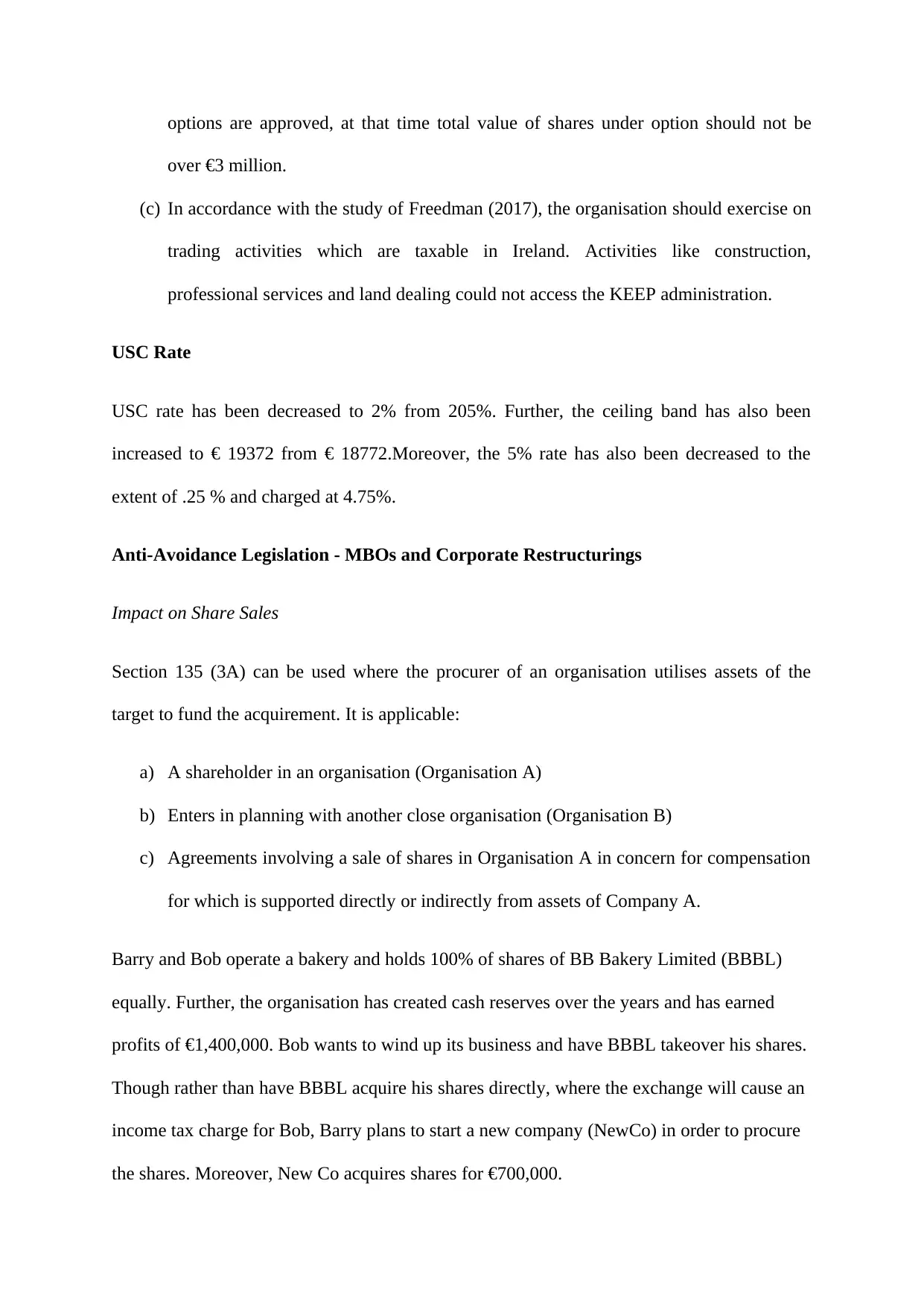
options are approved, at that time total value of shares under option should not be
over €3 million.
(c) In accordance with the study of Freedman (2017), the organisation should exercise on
trading activities which are taxable in Ireland. Activities like construction,
professional services and land dealing could not access the KEEP administration.
USC Rate
USC rate has been decreased to 2% from 205%. Further, the ceiling band has also been
increased to € 19372 from € 18772.Moreover, the 5% rate has also been decreased to the
extent of .25 % and charged at 4.75%.
Anti-Avoidance Legislation - MBOs and Corporate Restructurings
Impact on Share Sales
Section 135 (3A) can be used where the procurer of an organisation utilises assets of the
target to fund the acquirement. It is applicable:
a) A shareholder in an organisation (Organisation A)
b) Enters in planning with another close organisation (Organisation B)
c) Agreements involving a sale of shares in Organisation A in concern for compensation
for which is supported directly or indirectly from assets of Company A.
Barry and Bob operate a bakery and holds 100% of shares of BB Bakery Limited (BBBL)
equally. Further, the organisation has created cash reserves over the years and has earned
profits of €1,400,000. Bob wants to wind up its business and have BBBL takeover his shares.
Though rather than have BBBL acquire his shares directly, where the exchange will cause an
income tax charge for Bob, Barry plans to start a new company (NewCo) in order to procure
the shares. Moreover, New Co acquires shares for €700,000.
over €3 million.
(c) In accordance with the study of Freedman (2017), the organisation should exercise on
trading activities which are taxable in Ireland. Activities like construction,
professional services and land dealing could not access the KEEP administration.
USC Rate
USC rate has been decreased to 2% from 205%. Further, the ceiling band has also been
increased to € 19372 from € 18772.Moreover, the 5% rate has also been decreased to the
extent of .25 % and charged at 4.75%.
Anti-Avoidance Legislation - MBOs and Corporate Restructurings
Impact on Share Sales
Section 135 (3A) can be used where the procurer of an organisation utilises assets of the
target to fund the acquirement. It is applicable:
a) A shareholder in an organisation (Organisation A)
b) Enters in planning with another close organisation (Organisation B)
c) Agreements involving a sale of shares in Organisation A in concern for compensation
for which is supported directly or indirectly from assets of Company A.
Barry and Bob operate a bakery and holds 100% of shares of BB Bakery Limited (BBBL)
equally. Further, the organisation has created cash reserves over the years and has earned
profits of €1,400,000. Bob wants to wind up its business and have BBBL takeover his shares.
Though rather than have BBBL acquire his shares directly, where the exchange will cause an
income tax charge for Bob, Barry plans to start a new company (NewCo) in order to procure
the shares. Moreover, New Co acquires shares for €700,000.
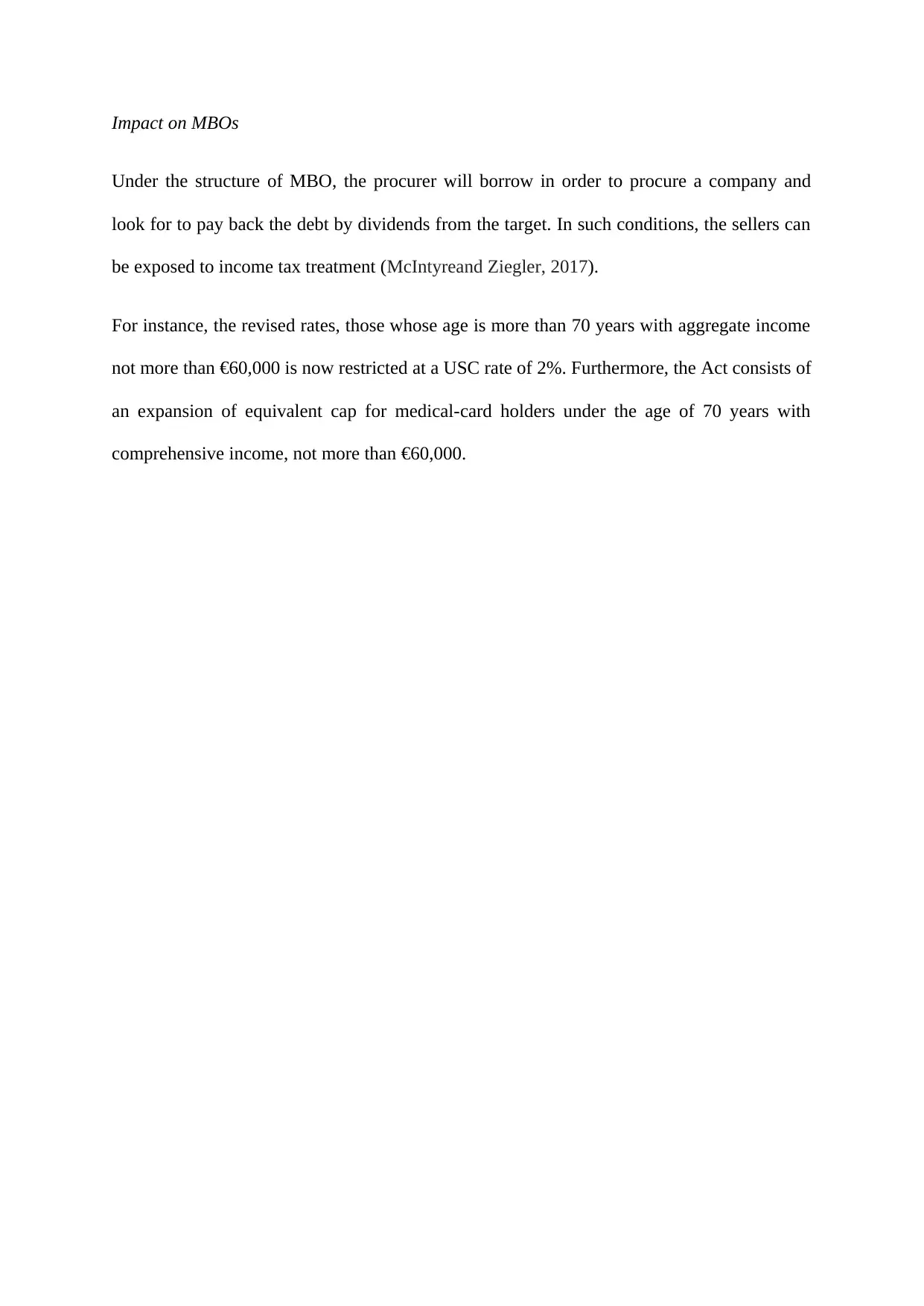
Impact on MBOs
Under the structure of MBO, the procurer will borrow in order to procure a company and
look for to pay back the debt by dividends from the target. In such conditions, the sellers can
be exposed to income tax treatment (McIntyreand Ziegler, 2017).
For instance, the revised rates, those whose age is more than 70 years with aggregate income
not more than €60,000 is now restricted at a USC rate of 2%. Furthermore, the Act consists of
an expansion of equivalent cap for medical-card holders under the age of 70 years with
comprehensive income, not more than €60,000.
Under the structure of MBO, the procurer will borrow in order to procure a company and
look for to pay back the debt by dividends from the target. In such conditions, the sellers can
be exposed to income tax treatment (McIntyreand Ziegler, 2017).
For instance, the revised rates, those whose age is more than 70 years with aggregate income
not more than €60,000 is now restricted at a USC rate of 2%. Furthermore, the Act consists of
an expansion of equivalent cap for medical-card holders under the age of 70 years with
comprehensive income, not more than €60,000.
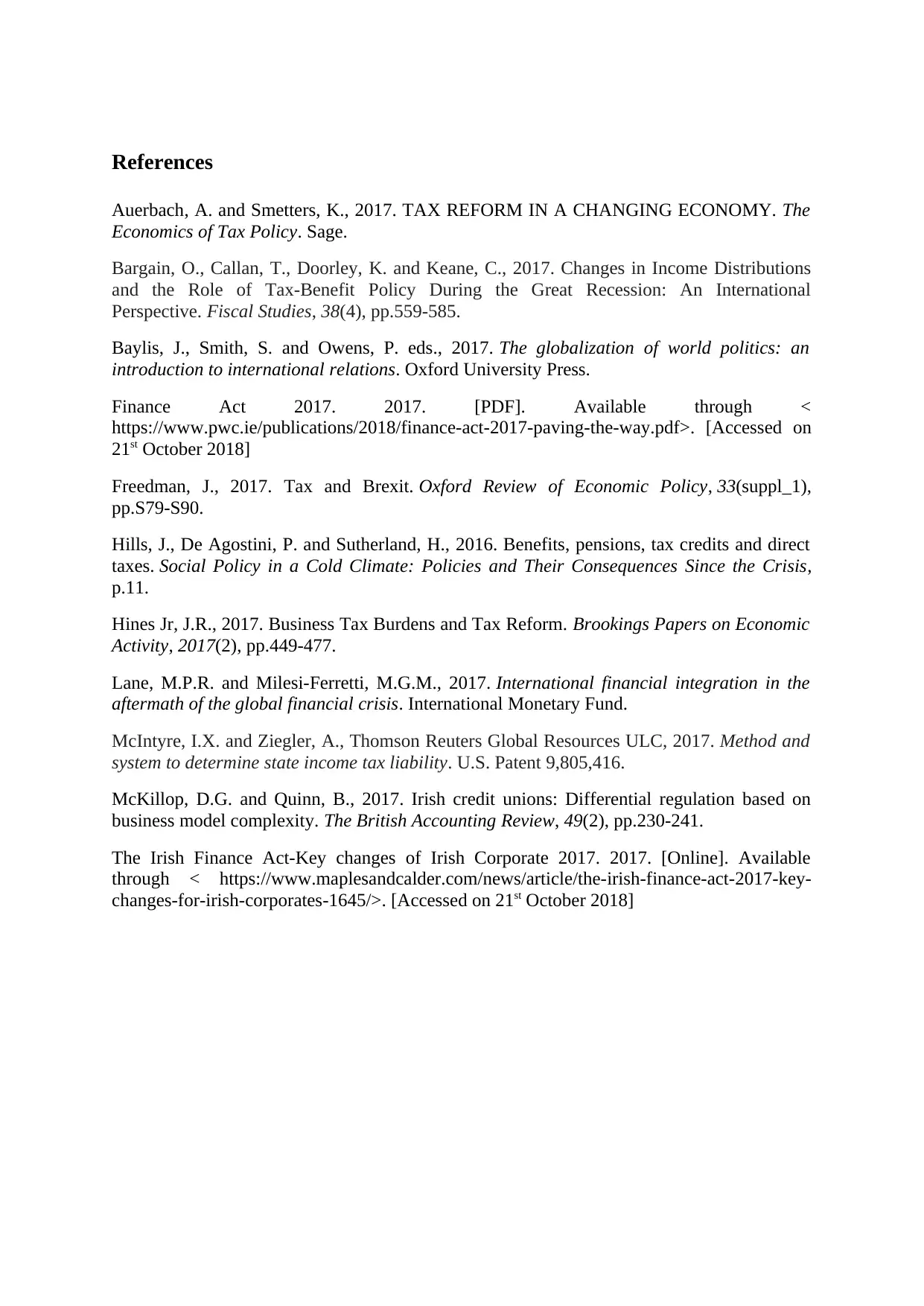
References
Auerbach, A. and Smetters, K., 2017. TAX REFORM IN A CHANGING ECONOMY. The
Economics of Tax Policy. Sage.
Bargain, O., Callan, T., Doorley, K. and Keane, C., 2017. Changes in Income Distributions
and the Role of Tax‐Benefit Policy During the Great Recession: An International
Perspective. Fiscal Studies, 38(4), pp.559-585.
Baylis, J., Smith, S. and Owens, P. eds., 2017. The globalization of world politics: an
introduction to international relations. Oxford University Press.
Finance Act 2017. 2017. [PDF]. Available through <
https://www.pwc.ie/publications/2018/finance-act-2017-paving-the-way.pdf>. [Accessed on
21st October 2018]
Freedman, J., 2017. Tax and Brexit. Oxford Review of Economic Policy, 33(suppl_1),
pp.S79-S90.
Hills, J., De Agostini, P. and Sutherland, H., 2016. Benefits, pensions, tax credits and direct
taxes. Social Policy in a Cold Climate: Policies and Their Consequences Since the Crisis,
p.11.
Hines Jr, J.R., 2017. Business Tax Burdens and Tax Reform. Brookings Papers on Economic
Activity, 2017(2), pp.449-477.
Lane, M.P.R. and Milesi-Ferretti, M.G.M., 2017. International financial integration in the
aftermath of the global financial crisis. International Monetary Fund.
McIntyre, I.X. and Ziegler, A., Thomson Reuters Global Resources ULC, 2017. Method and
system to determine state income tax liability. U.S. Patent 9,805,416.
McKillop, D.G. and Quinn, B., 2017. Irish credit unions: Differential regulation based on
business model complexity. The British Accounting Review, 49(2), pp.230-241.
The Irish Finance Act-Key changes of Irish Corporate 2017. 2017. [Online]. Available
through < https://www.maplesandcalder.com/news/article/the-irish-finance-act-2017-key-
changes-for-irish-corporates-1645/>. [Accessed on 21st October 2018]
Auerbach, A. and Smetters, K., 2017. TAX REFORM IN A CHANGING ECONOMY. The
Economics of Tax Policy. Sage.
Bargain, O., Callan, T., Doorley, K. and Keane, C., 2017. Changes in Income Distributions
and the Role of Tax‐Benefit Policy During the Great Recession: An International
Perspective. Fiscal Studies, 38(4), pp.559-585.
Baylis, J., Smith, S. and Owens, P. eds., 2017. The globalization of world politics: an
introduction to international relations. Oxford University Press.
Finance Act 2017. 2017. [PDF]. Available through <
https://www.pwc.ie/publications/2018/finance-act-2017-paving-the-way.pdf>. [Accessed on
21st October 2018]
Freedman, J., 2017. Tax and Brexit. Oxford Review of Economic Policy, 33(suppl_1),
pp.S79-S90.
Hills, J., De Agostini, P. and Sutherland, H., 2016. Benefits, pensions, tax credits and direct
taxes. Social Policy in a Cold Climate: Policies and Their Consequences Since the Crisis,
p.11.
Hines Jr, J.R., 2017. Business Tax Burdens and Tax Reform. Brookings Papers on Economic
Activity, 2017(2), pp.449-477.
Lane, M.P.R. and Milesi-Ferretti, M.G.M., 2017. International financial integration in the
aftermath of the global financial crisis. International Monetary Fund.
McIntyre, I.X. and Ziegler, A., Thomson Reuters Global Resources ULC, 2017. Method and
system to determine state income tax liability. U.S. Patent 9,805,416.
McKillop, D.G. and Quinn, B., 2017. Irish credit unions: Differential regulation based on
business model complexity. The British Accounting Review, 49(2), pp.230-241.
The Irish Finance Act-Key changes of Irish Corporate 2017. 2017. [Online]. Available
through < https://www.maplesandcalder.com/news/article/the-irish-finance-act-2017-key-
changes-for-irish-corporates-1645/>. [Accessed on 21st October 2018]
1 out of 13
Related Documents
Your All-in-One AI-Powered Toolkit for Academic Success.
+13062052269
info@desklib.com
Available 24*7 on WhatsApp / Email
![[object Object]](/_next/static/media/star-bottom.7253800d.svg)
Unlock your academic potential
© 2024 | Zucol Services PVT LTD | All rights reserved.





